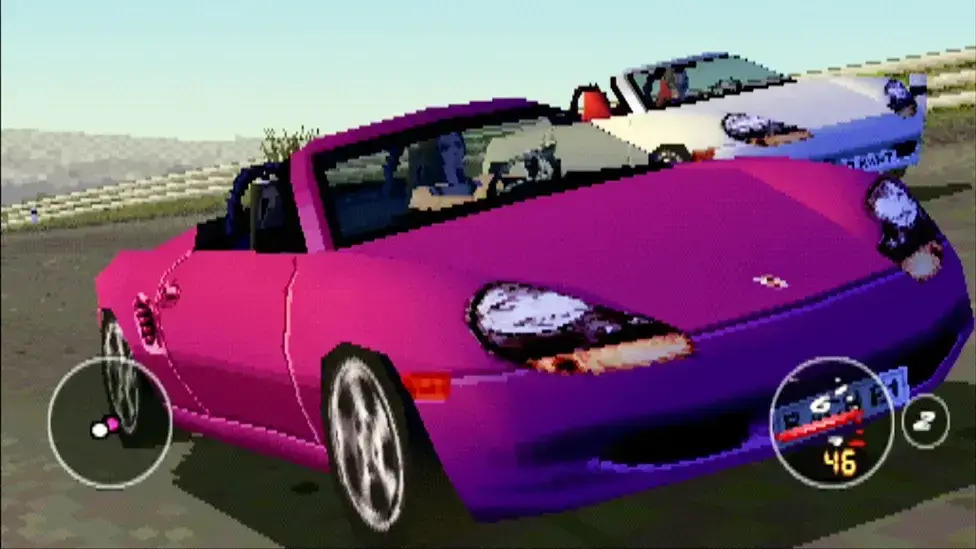
Instead of showcasing the iconic 911, it placed the spotlight squarely on the brand-new Porsche Boxster. What seemed like a niche title was actually a groundbreaking marketing move that blurred the line between gaming and automotive advertising.
The Boxster was Porsche's strategic attempt to broaden its customer base in the mid-1990s. To accelerate awareness, Porsche partnered with Sony's European development studio to produce Porsche Challenge, a racing title available exclusively on the PlayStation.
Rather than offering a stable of Porsche models, the game limited players to the first-generation Porsche 986 Boxster. That decision made the title function less as a simulator and more as an immersive brochure for a car the company wanted new buyers to covet.
Gameplay, characters and late-90s culture
Mechanically, the game was compact. There were just four core environments to race in, including Stuttgart, Porsche's hometown. To extend playtime, the developers added an "Interactive" mode that rearranged track layouts each lap — a clever but modest attempt to boost longevity.
On the grid, each Boxster was driven by a stereotyped character: a model, a DJ, a kickboxer and a hacker — the latter nodding to the 1990s fascination with films like Hackers. The roster and presentation read like a snapshot of pop culture in 1997 more than a serious motorsport simulation.
Quick facts
- Title: Porsche Challenge
- Platform: PlayStation (original)
- Release year: 1997
- Featured car: Porsche Boxster (first-generation, 986)
- Tracks: 4 core locations (including Stuttgart)
- Retail price at launch (UK): ~£40
- Manual highlight: Final five pages listed Porsche dealership contacts
More brochure than Gran Turismo
Contemporary critics and players noticed the game's limited scope. Where titles like Gran Turismo offered rich car lists and tuning depth, Porsche Challenge provided a singular driving experience. That narrowness, however, was intentional.
Porsche traded breadth for brand focus. Every menu, track and piece of documentation reinforced the Boxster's image. The instruction manual — which concluded with five pages of dealership names and phone numbers — revealed the project's commercial intent more plainly than any in-game logo could.
Why it mattered: gaming as a marketing channel
In hindsight, Porsche Challenge stands out as an early example of in-game product placement executed with full corporate backing. It anticipated the modern practice of aligning brands with interactive media to reach younger, tech-savvy audiences — much like how today's best racing games feature extensive manufacturer partnerships.
By placing the Boxster where PlayStation owners spent leisure time, Porsche converted gameplay into brand exposure. For many players, this was likely their first meaningful encounter with Porsche ownership as an attainable aspiration — even if only virtually.
Legacy and context
Today, the Boxster is a well-established Porsche model and the 986 is a recognized classic among enthusiasts. Porsche Challenge did not become a landmark racing classic, but it succeeded where it mattered to Porsche: it seeded awareness and desire for a new entry-level sports car.
For marketers and automotive historians, the title serves as a compact case study in early experiential advertising. It shows how gaming spaces could be leveraged to shape consumer perceptions long before influencer culture and large-scale in-game sponsorships became standard practice. This concept has evolved significantly, with modern race car manufacturers now investing heavily in esports and virtual racing programs.
The marketing approach also parallels how manufacturers like Manthey Racing showcase their Porsche builds today — creating immersive experiences that go beyond traditional advertising to build emotional connections with potential customers.
Takeaway: Porsche Challenge may not be the most-played vintage racer, but it proved that games could do more than entertain — they could launch products into culture.
Where to go next
If you're researching the intersection of gaming and automotive marketing, consider exploring modern parallels: licensed racing games that feature manufacturer pop-ups, branded esports initiatives, and in-game product integrations that go well beyond visual placement.




